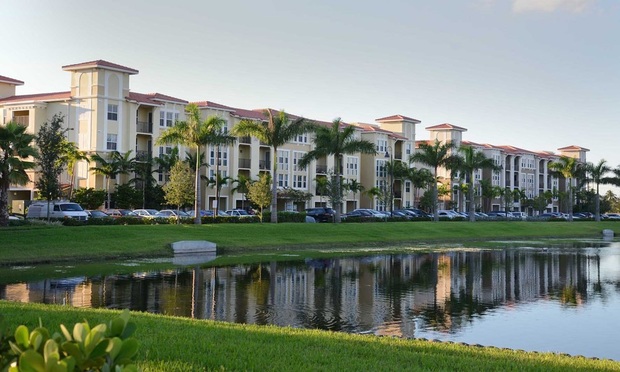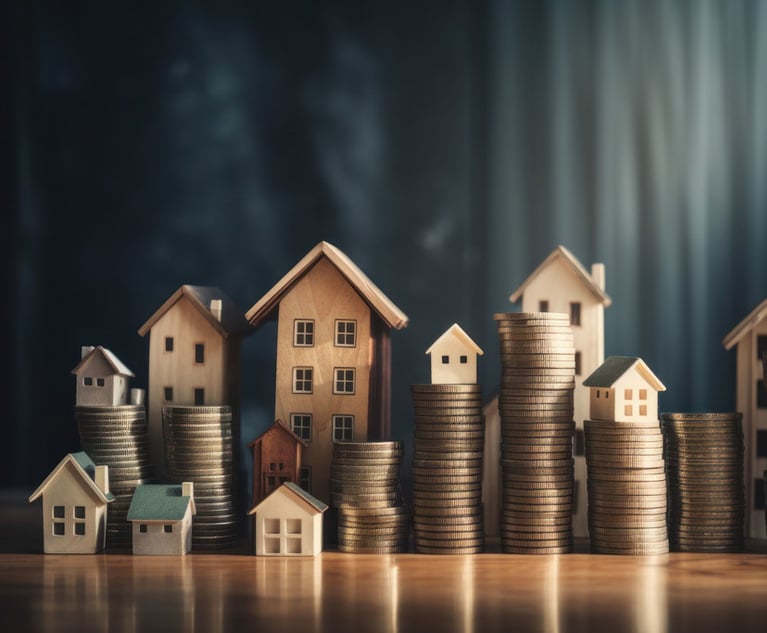Are Weakening Apartment Prices More Than a Correction?
Many investors are uncertain as to the staying power of the expansion, and interest rates are likely to rise further, suggesting that price weakness could persist following the amazing run-up that we have seen, Ten-X's Peter Muoio tells GlobeSt.com.
October 23, 2017 at 04:09 PM
6 minute read

Many multifamily investors are uncertain as to the staying power of the expansion, and interest rates are likely to rise further, suggesting that price weakness could persist following the amazing run-up that we have seen, Ten-X's chief economist Peter Muoio tells GlobeSt.com. According to the firm's CRE Nowcast, overall CRE pricing declined in September for the fifth consecutive month, and pricing in the apartment sector declined for the third consecutive month. With the prolonged slump, pricing's annual growth rate is at the lowest level since Nowcast was initiated, and several sectors are in similar slowdowns.
We sat down with Muoio to chat about apartment-sector pricing and where he sees it heading.
GlobeSt.com: What is your overall view of the continued weakening of apartment prices?
Muoio: We had been surprised earlier this year when apartment prices continued to rise while other segments were seeing the repercussions for the jump in interest rates after the election and the late-year Fed tightening, so the weakness over the last three months actually demonstrates that the segment can't defy gravity forever.
GlobeSt.com: Do you view this as simply a correction or does it have more dire implications for the sector?
Muoio: While apartment fundamentals are still generally quite healthy, most markets are seeing a decided upturn in delivery of new units to varying degrees, and as a result, while vacancies remain low, they have started to tick up. This, coupled with decelerating rent growth, has slowed NOI growth, and that trend is likely to continue. With many investors uncertain as to the staying power of the expansion and the likelihood of interest rates rising further, this outlook for fundamentals suggest that price weakness could persist following the amazing run-up that we have seen.
GlobeSt.com: What effect will continued price softening have on apartment rental rates and, ultimately, on the housing market?
Muoio: Rental rates are continuing to rise, though at a slightly slower pace, because vacancies are still low, notwithstanding the increases of late. In some markets the increase in deliveries has pushed vacancies up faster, with rents softening as a result. We expect national apartment rents to slow, but not decline in coming years, though again there will be differences market to market. In our estimation, we are at peak new supply this year and next, and then completions begin to simmer down.
Single-family housing affordability has its own issues: existing home prices are rising rapidly, and mortgage rates are up somewhat but vulnerable to increases in the coming years as Treasury rates rise. Housing is also dealing with very low inventories, furthering affordability concerns. So, while rising apartment rents would seemingly be favorable to single-family ownership, it is not that clear cut because of those issues and depends a lot on at which market you are looking.
GlobeSt.com: What else should our readers take away from this report?
Muoio: Commercial real estate prices across the segments are drifting after the run-up of recent years. This reflects the maturity of the expansion—soon to be the second-longest in modern history—rising interest rates and increasing supply pipelines in segments/markets. While economic growth continues to chug along, supporting demand for space, these other factors and all sorts of technology-based changes that have altered the way we use real estate space, suggest prices will remain under pressure.

Many multifamily investors are uncertain as to the staying power of the expansion, and interest rates are likely to rise further, suggesting that price weakness could persist following the amazing run-up that we have seen, Ten-X's chief economist Peter Muoio tells GlobeSt.com. According to the firm's CRE Nowcast, overall CRE pricing declined in September for the fifth consecutive month, and pricing in the apartment sector declined for the third consecutive month. With the prolonged slump, pricing's annual growth rate is at the lowest level since Nowcast was initiated, and several sectors are in similar slowdowns.
We sat down with Muoio to chat about apartment-sector pricing and where he sees it heading.
GlobeSt.com: What is your overall view of the continued weakening of apartment prices?
Muoio: We had been surprised earlier this year when apartment prices continued to rise while other segments were seeing the repercussions for the jump in interest rates after the election and the late-year Fed tightening, so the weakness over the last three months actually demonstrates that the segment can't defy gravity forever.
GlobeSt.com: Do you view this as simply a correction or does it have more dire implications for the sector?
Muoio: While apartment fundamentals are still generally quite healthy, most markets are seeing a decided upturn in delivery of new units to varying degrees, and as a result, while vacancies remain low, they have started to tick up. This, coupled with decelerating rent growth, has slowed NOI growth, and that trend is likely to continue. With many investors uncertain as to the staying power of the expansion and the likelihood of interest rates rising further, this outlook for fundamentals suggest that price weakness could persist following the amazing run-up that we have seen.
GlobeSt.com: What effect will continued price softening have on apartment rental rates and, ultimately, on the housing market?
Muoio: Rental rates are continuing to rise, though at a slightly slower pace, because vacancies are still low, notwithstanding the increases of late. In some markets the increase in deliveries has pushed vacancies up faster, with rents softening as a result. We expect national apartment rents to slow, but not decline in coming years, though again there will be differences market to market. In our estimation, we are at peak new supply this year and next, and then completions begin to simmer down.
Single-family housing affordability has its own issues: existing home prices are rising rapidly, and mortgage rates are up somewhat but vulnerable to increases in the coming years as Treasury rates rise. Housing is also dealing with very low inventories, furthering affordability concerns. So, while rising apartment rents would seemingly be favorable to single-family ownership, it is not that clear cut because of those issues and depends a lot on at which market you are looking.
GlobeSt.com: What else should our readers take away from this report?
Muoio: Commercial real estate prices across the segments are drifting after the run-up of recent years. This reflects the maturity of the expansion—soon to be the second-longest in modern history—rising interest rates and increasing supply pipelines in segments/markets. While economic growth continues to chug along, supporting demand for space, these other factors and all sorts of technology-based changes that have altered the way we use real estate space, suggest prices will remain under pressure.
This content has been archived. It is available through our partners, LexisNexis® and Bloomberg Law.
To view this content, please continue to their sites.
Not a Lexis Subscriber?
Subscribe Now
Not a Bloomberg Law Subscriber?
Subscribe Now
NOT FOR REPRINT
© 2025 ALM Global, LLC, All Rights Reserved. Request academic re-use from www.copyright.com. All other uses, submit a request to [email protected]. For more information visit Asset & Logo Licensing.
You Might Like
View All
Real Estate Trends to Watch in 2025: Restructuring, Growth, and Challenges in South Florida
3 minute read
830 Brickell is Open After Two-Year Delay That Led to Winston & Strawn Pulling Lease
3 minute readTrending Stories
- 111th Circuit Rejects Trump's Emergency Request as DOJ Prepares to Release Special Counsel's Final Report
- 2Supreme Court Takes Up Challenge to ACA Task Force
- 3'Tragedy of Unspeakable Proportions:' Could Edison, DWP, Face Lawsuits Over LA Wildfires?
- 4Meta Pulls Plug on DEI Programs
- 5On the Move and After Hours: Meyner and Landis; Cooper Levenson; Ogletree Deakins; Saiber
Who Got The Work
Michael G. Bongiorno, Andrew Scott Dulberg and Elizabeth E. Driscoll from Wilmer Cutler Pickering Hale and Dorr have stepped in to represent Symbotic Inc., an A.I.-enabled technology platform that focuses on increasing supply chain efficiency, and other defendants in a pending shareholder derivative lawsuit. The case, filed Oct. 2 in Massachusetts District Court by the Brown Law Firm on behalf of Stephen Austen, accuses certain officers and directors of misleading investors in regard to Symbotic's potential for margin growth by failing to disclose that the company was not equipped to timely deploy its systems or manage expenses through project delays. The case, assigned to U.S. District Judge Nathaniel M. Gorton, is 1:24-cv-12522, Austen v. Cohen et al.
Who Got The Work
Edmund Polubinski and Marie Killmond of Davis Polk & Wardwell have entered appearances for data platform software development company MongoDB and other defendants in a pending shareholder derivative lawsuit. The action, filed Oct. 7 in New York Southern District Court by the Brown Law Firm, accuses the company's directors and/or officers of falsely expressing confidence in the company’s restructuring of its sales incentive plan and downplaying the severity of decreases in its upfront commitments. The case is 1:24-cv-07594, Roy v. Ittycheria et al.
Who Got The Work
Amy O. Bruchs and Kurt F. Ellison of Michael Best & Friedrich have entered appearances for Epic Systems Corp. in a pending employment discrimination lawsuit. The suit was filed Sept. 7 in Wisconsin Western District Court by Levine Eisberner LLC and Siri & Glimstad on behalf of a project manager who claims that he was wrongfully terminated after applying for a religious exemption to the defendant's COVID-19 vaccine mandate. The case, assigned to U.S. Magistrate Judge Anita Marie Boor, is 3:24-cv-00630, Secker, Nathan v. Epic Systems Corporation.
Who Got The Work
David X. Sullivan, Thomas J. Finn and Gregory A. Hall from McCarter & English have entered appearances for Sunrun Installation Services in a pending civil rights lawsuit. The complaint was filed Sept. 4 in Connecticut District Court by attorney Robert M. Berke on behalf of former employee George Edward Steins, who was arrested and charged with employing an unregistered home improvement salesperson. The complaint alleges that had Sunrun informed the Connecticut Department of Consumer Protection that the plaintiff's employment had ended in 2017 and that he no longer held Sunrun's home improvement contractor license, he would not have been hit with charges, which were dismissed in May 2024. The case, assigned to U.S. District Judge Jeffrey A. Meyer, is 3:24-cv-01423, Steins v. Sunrun, Inc. et al.
Who Got The Work
Greenberg Traurig shareholder Joshua L. Raskin has entered an appearance for boohoo.com UK Ltd. in a pending patent infringement lawsuit. The suit, filed Sept. 3 in Texas Eastern District Court by Rozier Hardt McDonough on behalf of Alto Dynamics, asserts five patents related to an online shopping platform. The case, assigned to U.S. District Judge Rodney Gilstrap, is 2:24-cv-00719, Alto Dynamics, LLC v. boohoo.com UK Limited.
Featured Firms
Law Offices of Gary Martin Hays & Associates, P.C.
(470) 294-1674
Law Offices of Mark E. Salomone
(857) 444-6468
Smith & Hassler
(713) 739-1250








